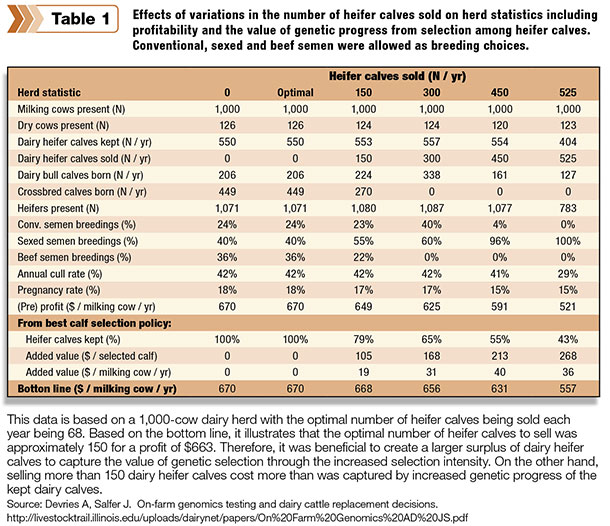With the arrival of lower-cost genomic testing options, an increasing number of registered purebred and commercial producers are using these tools for routine sorting and selection applications. While genomic testing costs have come down, they can still be substantial, and dairymen are searching for the most cost-effective applications of the technology. To address these issues, there are tools and strategies available that can help the producer make a good decision for their unique situation.
Whole-herd testing
Routinely testing the whole herd may be costly to the dairy producer, but it actually has some economic advantages if applied correctly. With this particular approach, the term “whole herd” is a bit of a misnomer for this discussion. Here, we are referring to “whole-herd testing” as the routine testing of all replacement females.
The basis behind this is the understanding that – with an appropriately high level of accuracy of the prediction – it will be possible to sort animals into outcome groups based on the criteria that meet the individual herd’s goals.
Furthermore, the value of the testing and selection on the improvement in genetic merit in the herd is increased if a smaller percentage of the tested animals are retained; thus, if you are testing replacements before selection, then you only want to keep the best.
Once testing is done, dairymen may take full advantage of the breeding and selling options available to them. If your test is accurate (the commercially available tools fit this category) and you are confident that it can reliably assign animals to the right groups of genetic potential, then one approach would be to use a trait such as net merit to rank the heifers.
An analysis indicated that with a reliability of approximately 60 percent from genomic testing, profitability from use of a $40 to $45 test could be maximized when the top 40 percent of heifers for net merit were bred using sexed semen, the bottom 36 percent were bred to beef semen, and 24 percent of heifers were bred with conventional semen.
With the increase in the value of the beef-cross calves out of the bottom-end replacements, it is possible to pay for much of the cost of testing for all of the replacements just from the increased value of those calves. The economics of this approach are dependent on demand for, and price of, beef feeder calves and the accuracy of the sorting, but the benefits are apparent (Table 1).
Pre-selection prior to testing
An alternative to whole-herd testing is the use of pre-selection for testing. The pre-selection can encompass several different techniques. One approach is to do health screening, which typically involves determining the status of persistent infection with bovine viral diarrhea (BVD) virus. From either a hair or a tissue sample, it is possible to test for BVD and then proceed to investment in genomic testing only for those animals that are negative for the disease.
A second approach to pre-selection is to rank heifers on the basis of their pedigree or parent average and only test those that fall above or below a predetermined threshold. The reliability of parent average – as compared to the reliability of the genomic data – is much lower and typically in the range of 20 to 30 percent, as compared to 60 to 70 percent for the genomic tests.
In a study of the economics of testing in replacement heifers, researchers looked at the economic impact of genomic testing under various scenarios of pedigree information, and proportion of animals being tested, together with the objectives of the program.
Unlike the previous example that included differential semen use as part of the economic model, this evaluation considered only the impact of testing and culling on lifetime net merit breeding value. Like the previous example, the genetic improvement in net merit in the herd is greatest when the genomic information is used to select and retain a small proportion of tested animals (Table 2).

One important factor to come out of this study was that the impact of genomic testing is highest when used in heifer calves or yearlings and when little or no pedigree information is known. If the full pedigree is known, then the value of the additional reliability from the genomic data is less.
Furthermore, the study also indicated that when testing is targeted at identifying the top 40 percent of animals to retain, as opposed to identifying the bottom 40 percent to cull, then there is a much larger effect on the lifetime net merit and genetic improvement in the herd.
Finally, the researchers evaluated different approaches to the testing of animals, looking at testing all animals, testing the top 50 percent, testing the bottom 50 percent or testing the middle 50 percent. In each scenario, returns were improved when all animals were tested and only a small percentage of the superior animals were retained. If the goal was to identify the most inferior animals and cull them to reduce costs, the returns were least.
Summary
A variety of options exist for genomic testing in commercial dairy herds, and economic models are available to help guide the dairy producer. The differential application of the testing can be as simple as pre-screening for disease and only testing those free of disease in order to save costs on animals you know you won’t keep.
Pre-screening using pedigree and performance data, and testing a portion of the top animals to identify only those you know to be superior, will reduce costs and improve the rate of genetic progress in the herd.
Finally, a broader application of testing coupled with differential use of conventional, sexed and beef semen can provide the greatest return, not only in terms of genetic progress but also in value of cull calves – especially in cases where beef prices are high and demand for feeder calves is strong. Whatever approach you choose, the decreasing cost of testing, coupled with improved accuracy of the prediction, means the economics are in your favor. PD
Stewart Bauck is a general manager with Neogen Corporation. He can be contacted by email.
References have been omitted due to space but are available upon request. Click here to email an editor.







